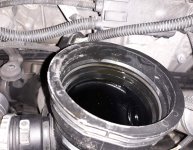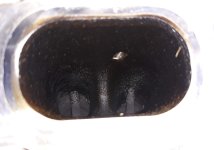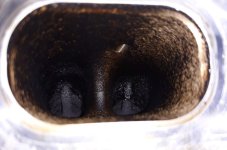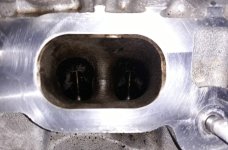CRC Intake Valve Cleaner. Dissolves the carbon buildup. The instructions say to spray it into the throttle body (past the MAF sensor) with the engine running blah blah, but I do not want stuff going through the engine and cats, so the other method is similar to walnut blasting (remove the intake manifold and to access the back of the valves directly) except you spray the cleaner instead of blasting with any media.Smartbear said:What medium are you using if it’s not walnut shell? :?
Rob
You are using an out of date browser. It may not display this or other websites correctly.
You should upgrade or use an alternative browser.
You should upgrade or use an alternative browser.
Doing an Intake Valve Clean - any tips?
- Thread starter enzed4
- Start date
enzed4 said:CRC Intake Valve Cleaner. Dissolves the carbon buildup. The instructions say to spray it into the throttle body (past the MAF sensor) with the engine running blah blah, but I do not want stuff going through the engine and cats, so the other method is similar to walnut blasting (remove the intake manifold and to access the back of the valves directly) except you spray the cleaner instead of blasting with any media.
I think spraying in while the engine is running you would have to use the intake cleaner on a regular basis to keep the values clean, say every 1k miles, it does a good job of removing the carbon buildup but to remove large deposits they need to be submerged for a while to dissolve it,
If you aren’t using any medium to blast the valves you will need some sharp tools to scrape the carbon off once it’s been softened, the cleaner turns it to a tar like consistency, you would be better getting 2 or 3 cans as I found the reaction stopped after a while and had to keep re applying even with using the walnuts to remove all the deposits
If using the product while the engine is running the manufacturer recommends every 16,000km (or sooner if symptoms occur) which seems an admission that its not as effective used that way. I have 2 cans of the intake cleaner and 2 cans of brake cleaner, a syringe and tubing, and a false sense of confidence :lol:Chippie said:enzed4 said:CRC Intake Valve Cleaner. Dissolves the carbon buildup. The instructions say to spray it into the throttle body (past the MAF sensor) with the engine running blah blah, but I do not want stuff going through the engine and cats, so the other method is similar to walnut blasting (remove the intake manifold and to access the back of the valves directly) except you spray the cleaner instead of blasting with any media.
I think spraying in while the engine is running you would have to use the intake cleaner on a regular basis to keep the values clean, say every 1k miles, it does a good job of removing the carbon buildup but to remove large deposits they need to be submerged for a while to dissolve it,
If you aren’t using any medium to blast the valves you will need some sharp tools to scrape the carbon off once it’s been softened, the cleaner turns it to a tar like consistency, you would be better getting 2 or 3 cans as I found the reaction stopped after a while and had to keep re applying even with using the walnuts to remove all the deposits
I'm confused as to what good spaying the cleaner into the intake will do since that airflow does not wash over the backside of the intake valve where the unwanted deposit is accumulated.
The you tube video linked showed the intake removed and the solvent working well to completely dissolve the deposits.
Also google search reveals you can rotate the engine crankshaft with a big ratchet on the (21-22mm) bolt on the largest pulley on the engine with the plugs out. Manual transmissions need to be in neutral.
The you tube video linked showed the intake removed and the solvent working well to completely dissolve the deposits.
Also google search reveals you can rotate the engine crankshaft with a big ratchet on the (21-22mm) bolt on the largest pulley on the engine with the plugs out. Manual transmissions need to be in neutral.
scootr said:I'm confused as to what good spaying the cleaner into the intake will do since that airflow does not wash over the backside of the intake valve where the unwanted deposit is accumulated.
The you tube video linked showed the intake removed and the solvent working well to completely dissolve the deposits.
Also google search reveals you can rotate the engine crankshaft with a big ratchet on the (21-22mm) bolt on the largest pulley on the engine with the plugs out. Manual transmissions need to be in neutral.
Surely if the valves being cleaned are fully closed then the cleaner will have access to every part of the surface of those valves. What part would be inaccessible? :?
Rob
Smartbear said:scootr said:I'm confused as to what good spaying the cleaner into the intake will do since that airflow does not wash over the backside of the intake valve where the unwanted deposit is accumulated.
The you tube video linked showed the intake removed and the solvent working well to completely dissolve the deposits.
Also google search reveals you can rotate the engine crankshaft with a big ratchet on the (21-22mm) bolt on the largest pulley on the engine with the plugs out. Manual transmissions need to be in neutral.
Surely if the valves being cleaned are fully closed then the cleaner will have access to every part of the surface of those valves. What part would be inaccessible? :?
Rob
I think he mean spraying with the engine running, as the air flow will hit the front and side’s of the valves and not the back, but if done on a regular basis then surely it would keep the valves clean as the oil/carbon deposits also flow with the air past the valves hitting mainly the front and side’s of the valves
Chippie said:Smartbear said:scootr said:I'm confused as to what good spaying the cleaner into the intake will do since that airflow does not wash over the backside of the intake valve where the unwanted deposit is accumulated.
The you tube video linked showed the intake removed and the solvent working well to completely dissolve the deposits.
Also google search reveals you can rotate the engine crankshaft with a big ratchet on the (21-22mm) bolt on the largest pulley on the engine with the plugs out. Manual transmissions need to be in neutral.
Surely if the valves being cleaned are fully closed then the cleaner will have access to every part of the surface of those valves. What part would be inaccessible? :?
Rob
I think he mean spraying with the engine running, as the air flow will hit the front and side’s of the valves and not the back, but if done on a regular basis then surely it would keep the valves clean as the oil/carbon deposits also flow with the air past the valves hitting mainly the front and side’s of the valves
I think the oil/carbon residue is mainly deposited during the valve overlap phase of combustion with the direct injection engines, so doesn’t coat the valves in the same way.
It’s just air hitting the valves from the inlet manifold (with a slight amount from the ccv just for good luck)
Rob
Smartbear said:Chippie said:Smartbear said:Surely if the valves being cleaned are fully closed then the cleaner will have access to every part of the surface of those valves. What part would be inaccessible? :?
Rob
I think he mean spraying with the engine running, as the air flow will hit the front and side’s of the valves and not the back, but if done on a regular basis then surely it would keep the valves clean as the oil/carbon deposits also flow with the air past the valves hitting mainly the front and side’s of the valves
I think the oil/carbon residue is mainly deposited during the valve overlap phase of combustion with the direct injection engines, so doesn’t coat the valves in the same way.
It’s just air hitting the valves from the inlet manifold (with a slight amount from the ccv just for good luck)
Rob
A quick google search found this:
Although intake valve deposits are a normal by-product of combustion, they can build up quicker if the valve guides or seals are worn, or in vehicles with variable valve timing, where the valves are open for longer and are therefore exposed to more carbon particles.
On a direct injection engine its considered good practice to fit a baffled oil catch can, mishimoto make the best.
You can buy it as a kit with all hoses etc.
In a nutshell the catch can is a small 'can' with a filter to catch oil mist and a baffle to stop 'slop' if your driving it like a grand theft auto muppet.
It connects between the crankcase breather and the inlet manifold and reduces the amount of crankcase oil mist entering the inlet manifold, this mist and crud is what builds up on your valves.
The amount of crud is relevant to engine wear and age so the older the car/engine gets the more useful the can is.
See my post here https://z4-forum.com/forum/viewtopic.php?f=23&t=119149&p=1705789#p1705789
You can buy it as a kit with all hoses etc.
In a nutshell the catch can is a small 'can' with a filter to catch oil mist and a baffle to stop 'slop' if your driving it like a grand theft auto muppet.
It connects between the crankcase breather and the inlet manifold and reduces the amount of crankcase oil mist entering the inlet manifold, this mist and crud is what builds up on your valves.
The amount of crud is relevant to engine wear and age so the older the car/engine gets the more useful the can is.
See my post here https://z4-forum.com/forum/viewtopic.php?f=23&t=119149&p=1705789#p1705789
I like this a lot, but at that price I can't see keeping the car long enough to justify it. I hope that statement doesn't come back to bite me a few years from now... :roll:mcbutler said:On a direct injection engine its considered good practice to fit a baffled oil catch can, mishimoto make the best.
You can buy it as a kit with all hoses etc.
In a nutshell the catch can is a small 'can' with a filter to catch oil mist and a baffle to stop 'slop' if your driving it like a grand theft auto muppet.
It connects between the crankcase breather and the inlet manifold and reduces the amount of crankcase oil mist entering the inlet manifold, this mist and crud is what builds up on your valves.
The amount of crud is relevant to engine wear and age so the older the car/engine gets the more useful the can is.
See my post here https://z4-forum.com/forum/viewtopic.php?f=23&t=119149&p=1705789#p1705789
Spent most of yesterday doing the intake clean. The actual removal of bits to get to the intake manifold wasn't as hard as I thought it would be EXCEPT the 'junction box' that is attached to the underside of the manifold cover. An absolutely mare to remove, despite the 2 seconds it took the guy on the video. I simply could not depress the metal tabs enough to slip them under the plastic brackets on the junction box. I read through the comments and found a comment from another viewer who said they also found it impossible, and instead unclipped the top half of the junction box from the bottom and took it out with the manifold. I couldn't even manage this so in the end managed to unscrew the 3 T25 torx screws holding the junction box to the manifold. Not easy but got there in the end :headbang:
Anyway, on removing the charge pipe from the throttle body I thought things weren't going to look good in the intake judging by the oil in the charge pipe:

Once the manifold was removed, the buildup of carbon was as expected. I won't post every valve but these are indicative:


Two cans of the CRC intake cleaner later and I would say the inlet and valves/stems were about 90-95% better. You could spend hours and hours trying to get every last bit out if you really wanted. I certainly believe the walnut blasting would do a better job, but there's no one in my area offering the service (that I'm aware of), so it's the best I could do.

I'd agree with most people who have done this. The car felt a bit smoother (especially on cold start/idle), a bit more 'torquey' and so on. All based on the scientifically proven 'butt dyno' of course. I do have MHD logs of pulls done today, but I think they're pretty useless as the trans stepped down on acceleration - I really want to see data logged in the same gear. Next time I'm out I'll code the car to not step down at WOT (or wherever it decides to do it).
BMS FMIC and charge pipe on their way, should be here during the week, so looks like next weekend's job. Then I'll try the Stage 1 map again. If all goes well after a while I'll also try the Stage 1+. I have stage 2 maps available but without DP's I'm not sure I should go there yet.
Looking forward to seeing an improvement in IAT's now that I can monitor them with MHD; I've been logging them on the stock FMIC so will hopefully see a good, measureable improvement.
Anyway, on removing the charge pipe from the throttle body I thought things weren't going to look good in the intake judging by the oil in the charge pipe:

Once the manifold was removed, the buildup of carbon was as expected. I won't post every valve but these are indicative:


Two cans of the CRC intake cleaner later and I would say the inlet and valves/stems were about 90-95% better. You could spend hours and hours trying to get every last bit out if you really wanted. I certainly believe the walnut blasting would do a better job, but there's no one in my area offering the service (that I'm aware of), so it's the best I could do.

I'd agree with most people who have done this. The car felt a bit smoother (especially on cold start/idle), a bit more 'torquey' and so on. All based on the scientifically proven 'butt dyno' of course. I do have MHD logs of pulls done today, but I think they're pretty useless as the trans stepped down on acceleration - I really want to see data logged in the same gear. Next time I'm out I'll code the car to not step down at WOT (or wherever it decides to do it).
BMS FMIC and charge pipe on their way, should be here during the week, so looks like next weekend's job. Then I'll try the Stage 1 map again. If all goes well after a while I'll also try the Stage 1+. I have stage 2 maps available but without DP's I'm not sure I should go there yet.
Looking forward to seeing an improvement in IAT's now that I can monitor them with MHD; I've been logging them on the stock FMIC so will hopefully see a good, measureable improvement.
"Butt Dyno" :rofl:enzed4 said:Spent most of yesterday doing the intake clean. The actual removal of bits to get to the intake manifold wasn't as hard as I thought it would be EXCEPT the 'junction box' that is attached to the underside of the manifold cover. An absolutely mare to remove, despite the 2 seconds it took the guy on the video. I simply could not depress the metal tabs enough to slip them under the plastic brackets on the junction box. I read through the comments and found a comment from another viewer who said they also found it impossible, and instead unclipped the top half of the junction box from the bottom and took it out with the manifold. I couldn't even manage this so in the end managed to unscrew the 3 T25 torx screws holding the junction box to the manifold. Not easy but got there in the end :headbang:
Anyway, on removing the charge pipe from the throttle body I thought things weren't going to look good in the intake judging by the oil in the charge pipe:
chargepipe01.jpg
Once the manifold was removed, the buildup of carbon was as expected. I won't post every valve but these are indicative:
intake01.jpg
intake02..jpg
Two cans of the CRC intake cleaner later and I would say the inlet and valves/stems were about 90-95% better. You could spend hours and hours trying to get every last bit out if you really wanted. I certainly believe the walnut blasting would do a better job, but there's no one in my area offering the service (that I'm aware of), so it's the best I could do.
intake03.jpg
I'd agree with most people who have done this. The car felt a bit smoother (especially on cold start/idle), a bit more 'torquey' and so on. All based on the scientifically proven 'butt dyno' of course. I do have MHD logs of pulls done today, but I think they're pretty useless as the trans stepped down on acceleration - I really want to see data logged in the same gear. Next time I'm out I'll code the car to not step down at WOT (or wherever it decides to do it).
BMS FMIC and charge pipe on their way, should be here during the week, so looks like next weekend's job. Then I'll try the Stage 1 map again. If all goes well after a while I'll also try the Stage 1+. I have stage 2 maps available but without DP's I'm not sure I should go there yet.
Looking forward to seeing an improvement in IAT's now that I can monitor them with MHD; I've been logging them on the stock FMIC so will hopefully see a good, measureable improvement.
I wouldn't bother with the charge pipe. It was a common failure point on the 3 series but I've not seen a failure reported on the Z4. It's mainly the people selling them that push it as a must-have mod.
I've had my stock one dealing with 18PSI for the last 5 years and it's been fine.
I've had my stock one dealing with 18PSI for the last 5 years and it's been fine.
Oh well, too late now, its on the way. Clearly the marketing worked on me (and most of the threads I read about these issues are on 3 series forums). I didn't even think to ask if it was necessary on the Z4 - more fool me :lol: I just assumed that because the engine is the same, that the charge pipe would experience the same problems being plastic. Lesson learned....R.E92 said:I wouldn't bother with the charge pipe. It was a common failure point on the 3 series but I've not seen a failure reported on the Z4. It's mainly the people selling them that push it as a must-have mod.
I've had my stock one dealing with 18PSI for the last 5 years and it's been fine.
Great that you managed this. Since buying our 35i last May I have been planning to do this, have the two CRC cans sitting ready. The car has close to 100K miles and according to the PO it's never been done. My wife mostly uses the car, for very short trips (<2 miles a day) to her yoga back and forth, so that can't be helping. The thing is though, when we got it, it would have the slightest hint of an irregular idle which I attributed to carbon deposits (after replacing plugs and filters). But that has since slowly disappeared and now the car runs super-smooth. So I am afraid to disturb all that piping and gaskets and components and leave well enough alone. No codes, passed smog easily, low fuel consumption. What's a fella to do. This car even still has the original injectors, never any major work done. I'm sure now I jinxed it!
Cees Klumper said:Great that you managed this. Since buying our 35i last May I have been planning to do this, have the two CRC cans sitting ready. The car has close to 100K miles and according to the PO it's never been done. My wife mostly uses the car, for very short trips (<2 miles a day) to her yoga back and forth, so that can't be helping. The thing is though, when we got it, it would have the slightest hint of an irregular idle which I attributed to carbon deposits (after replacing plugs and filters). But that has since slowly disappeared and now the car runs super-smooth. So I am afraid to disturb all that piping and gaskets and components and leave well enough alone. No codes, passed smog easily, low fuel consumption. What's a fella to do. This car even still has the original injectors, never any major work done. I'm sure now I jinxed it!
The best thing for the car would be to ban your wife from driving it, 2miles a day is terrible for any car!
Rob
I agree. But I love her.
The car, or the wife? :lol:Cees Klumper said:I agree. But I love her.
I hear you about wondering whether to do it or not. Sometimes you feel like you're looking for a problem to fix that might just not be there in the first place. If you're on 100K miles I can only imagine what the intakes look like
enzed4 said:CRC Intake Valve Cleaner. Dissolves the carbon buildup. The instructions say to spray it into the throttle body (past the MAF sensor) with the engine running blah blah, but I do not want stuff going through the engine and cats, so the other method is similar to walnut blasting (remove the intake manifold and to access the back of the valves directly) except you spray the cleaner instead of blasting with any media.Smartbear said:What medium are you using if it’s not walnut shell? :?
Rob
Where did you get the CRC Cleaner from and how much was it?
Similar threads
- Replies
- 8
- Views
- 421
- Replies
- 19
- Views
- 916
- Replies
- 5
- Views
- 420
- Replies
- 10
- Views
- 753